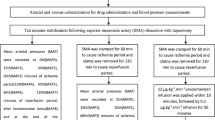Abstract
The liver is an organ with a very high metabolic rate and thereby also a target for the formation and activity of free oxygen radicals. Most substances to be detoxified reach the liver as they progress from the intestinal circulation through the portal vein. During the continued inflow of such substances and by local processes, a certain amount of lipid peroxides is generated under the influence of simultaneously produced free oxygen radicals. Such lipid peroxides react with thiobarbituric acid in the same way as malondialdehyde. Thus the content of lipid peroxides can be expressed in terms of malondialdehyde.
Access this chapter
Tax calculation will be finalised at checkout
Purchases are for personal use only
Preview
Unable to display preview. Download preview PDF.
Similar content being viewed by others
References
Adkison, D., Höllwarth, M.E., Benoit, J.N., Parks, D.A., McCord, J.M. and Granger, D.N. (1986). Role of free radicals in ischemia-reperfusion injury to the liver. Acta Physiol. Scand. Suppl. 548., 101–107.
Augustin, A. and Lutz, J. (1988). The effect of a temporary occlusion of the superior mesenteric artery on the level of lipid peroxides in plasma and intestinal tissue. Pflueg. Arch. 411, R108.
Granger, D.N., Rutili G. and McCord, J.M. (1981). Superoxide radicals in feline intestinal ischemia. Gastroent. 81., 22–29.
Granger, D.N., Höllwarth M.E. and Parks, D.A. (1986). Ischemia-reperfusion injury: role of oxygen-derived free radicals. Acta Physiol. Scand. Suppl. 548, 47–63.
Haglind, E., Haglund, U., Lundgren O. and Schersten, T. (1981). Graded intestinal vascular obstruction. II. Effects of antibiotic pretreatment in the rat. Circulat. Shock 8, 41–47.
Haglund, U. and Lundgren, O. (1972). Reactions within consecutive vascular sections of the small intestine of the cat during prolonged hypotension. Act. Physiol. Scand. 84 151–161.
Hamar, J., Dezsi, L., Adam, E., Egri, L., Netzer, K.O., Stark, M. and Lutz, J. (1987). Role of fluid replacement, increased oxygen availability by perfluorochemicals and enhanced RES function in the treatment of mesenteric occlusion shock. Res. Exp. Med. 187, 451–459.
Lutz, J. (1977). Hämodynamik und Sauerstoffversorgung der Leber. In: Experimentelle Hepatologie. (Edit. O. Zelder, M. Fischer and H. Hamelmann). Falck, Freiburg p. 1–14.
Lutz, J., Hamar, J., Netzer, K.O. and Stark, M. (1985). Survival from mesenteric occlusion shock influenced by different treatment in rats. Int. J. Microcirc. Clin. Exp. 4, 103.
Lutz, J. and Schultze, H.G. (1978). Oxygen consumption and oxygen extraction of the feline liver under different types of induced hypoxia. In: Oxygen transport to tissue III (Edit. I.A. Silver, M. Erecinska and H.I. Bicher), Plenum Pub. Corp. N.Y. p. 537–543.
Moorhouse P.C., Grootveld M., Halliwell, B., Quinlan J.G. and Gutteridge. J.M.C. (1987). Allopurinol and oxypurinol are hydroxyl radical scavengers. FEBS letters 213, 23–28.
Ohkawa, H., Ohishi, N. and Yagi, K. (1979). Assay for lipid peroxides in animal tissues by thiobarbituric acid reaction. Analytical Biochem. 95, 351–358.
Parks, D.A., Bulkley, G.B., Granger, D.N., Hamilton, S.R. and McCord, J.M. (1982). Ischemic injury in the cat small intestine: role of superoxide radicals. Gastroenterol. 82, 9–15.
Parks, D.A., Shah, A.K. and Granger, D.N. (1984). Oxygen radicals: effects on intestinal vascular permeability. Amer. J. Physiol. 247, G167–G170.
Yagi, K. (1982). Assay for serum lipid peroxide level and its clinical significance. In: Lipid peroxides in biology and medicine. Academic Press Inc. p. 223–242.
Author information
Authors and Affiliations
Editor information
Editors and Affiliations
Rights and permissions
Copyright information
© 1989 Plenum Press, New York
About this chapter
Cite this chapter
Lutz, J., Augustin, A. (1989). The Influence of a Temporary Cessation and Reperfusion of Intestinal Blood Flow on the Level of Hepatic Lipid Peroxides. In: Rakusan, K., Biro, G.P., Goldstick, T.K., Turek, Z. (eds) Oxygen Transport to Tissue XI. Advances in Experimental Medicine and Biology, vol 248. Springer, Boston, MA. https://doi.org/10.1007/978-1-4684-5643-1_91
Download citation
DOI: https://doi.org/10.1007/978-1-4684-5643-1_91
Publisher Name: Springer, Boston, MA
Print ISBN: 978-1-4684-5645-5
Online ISBN: 978-1-4684-5643-1
eBook Packages: Springer Book Archive




